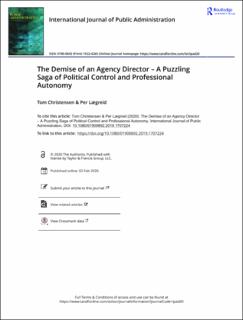| dc.contributor.author | Christensen, Tom | |
| dc.contributor.author | Lægreid, Per | |
| dc.date.accessioned | 2021-05-20T12:51:41Z | |
| dc.date.available | 2021-05-20T12:51:41Z | |
| dc.date.created | 2020-02-03T14:19:03Z | |
| dc.date.issued | 2020-02-02 | |
| dc.Published | International Journal of Public Administration. 2020, . | |
| dc.identifier.issn | 0190-0692 | |
| dc.identifier.uri | https://hdl.handle.net/11250/2755911 | |
| dc.description.abstract | This article aims at addressing the relationship between expertise and politics by examining a reorganization process of Statistics Norway. The puzzle is why a minor reorganization with low political salience, in a consensus-oriented political administrative setting with high level of trust between ministries and agencies, and high autonomy for agencies ended up as a major conflict resulting in the resignation of the agency director. Based on an instrumental, a cultural and a symbolic perspective the article examines the internal and external dynamics ensuing from conflicting views regarding the balance between political control and professional autonomy, and from reorganization proposals that represented a break with the cultural path the organization had followed. It adds insights into the tensions between different types of institutional logics, resulting in institutional hybridity. | en_US |
| dc.language.iso | eng | en_US |
| dc.publisher | Routledge | en_US |
| dc.rights | Attribution-NonCommercial-NoDerivatives 4.0 Internasjonal | * |
| dc.rights.uri | http://creativecommons.org/licenses/by-nc-nd/4.0/deed.no | * |
| dc.title | The Demise of an Agency Director – A Puzzling Saga of Political Control and Professional Autonomy. | en_US |
| dc.type | Journal article | en_US |
| dc.type | Peer reviewed | en_US |
| dc.description.version | publishedVersion | en_US |
| dc.rights.holder | Copyright 2020 The Author(s) | en_US |
| cristin.ispublished | true | |
| cristin.fulltext | original | |
| cristin.qualitycode | 1 | |
| dc.identifier.doi | 10.1080/01900692.2019.1707224 | |
| dc.identifier.cristin | 1790272 | |
| dc.source.journal | International Journal of Public Administration | en_US |
| dc.source.pagenumber | 250-261 | en_US |
| dc.identifier.citation | International Journal of Public Administration. 2021, 44 (3), 250-261 | en_US |
| dc.source.volume | 44 | en_US |
| dc.source.issue | 3 | en_US |

